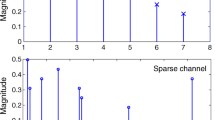Abstract
Channel estimation normally provides information about indoor and outdoor fading channel statistics. The adaptive channel estimation models play an important role to generate the required channel state information (CSI) using the estimated channel coefficient vector. The CSI can be utilized to generate an angle vector that controls the steering mechanism of a beamformer. The beamformer provides better directive gain for linear antenna array and helps to improve the signal to noise ratio of the wireless receiver. The proposed estimation model process the transmitted quadrature amplitude modulation (QAM) data samples in the frequency domain. The adaptive design incorporates norm-based sparsity through block recursive least square (BRLS) algorithm to develop a computationally efficient model. The proposed sparse-FBRLS (Fast BRLS) model has simultaneously addressed the problems of channel estimation and beamforming in case of indoor and outdoor communication. The performance of the model is tested by different performance measures under practical mobility conditions.










Similar content being viewed by others
References
Haykin, S.S.: Adaptive Filter Theory, 3 edn. Pearson Education India, p. 989 (1996)
Yang, K.-J., Wang, C.-L., Tsai, Y.-R.: Joint channel and Doppler spread estimation over time varying flat fading channels. In: Vehicular Technology Conference (VTC Spring) (2012)
Madni, H.M.F.A., Ali, B., Butt, M.F.U.: Study and analysis of channel estimation techniques for OFDM based wireless communication systems. In: 12th International Conference on Frontiers of Information Technology, Islamabad, pp. 56–60 (2014). https://doi.org/10.1109/fit.2014.20
Zhang, Z., Xiao, L., Su, X., Zeng, J., Xu, X.: A channel estimation method based on the improved LMS algorithm for MIMO-OFDM systems. In: 2018 12th International Symposium on Medical Information and Communication Technology (ISMICT), Sydney, NSW, pp. 1–5 (2018). https://doi.org/10.1109/ismict.2018.8573728
Acar, Y., Dogati, H., Panayirci, E.: Iterative channel estimation for spatial modulation systems over fast fading channels. In: Signal Processing and Communications Applications Conference (2014)
Mohanty, B., Sahoo, H.K., Patnaik, B.: Block NLMS/F based equalizer design and channel capacity analysis for indoor IEEE 802.11 fading wireless channels. Signal Image Video Process. 13(4), 693–701 (2019)
Sahoo, H.K., Mohanty, B., Patnaik, B.: Block and fast block sparse adaptive filtering for outdoor wireless channel estimation and equalization. Wirel. Pers. Commun. 98(3), 3003–3019 (2017)
Dakulagi, V., Bakhar, M.: Advances in smart antenna systems for wireless communication. Wirel. Pers. Commun. 110, 931–957 (2020). https://doi.org/10.1007/s11277-019-06764-6
Van Veen, B.D., Buckley, K.M.: Beam forming: a versatile approach to spatial filtering. IEEE ASSP Mag. 5(2), 4–24 (1998)
Xi, Z., Zhang, W.: DOA estimation and self-calibration in partially calibrated subarray-based uniform linear arrays. SIViP 14, 233–239 (2020)
Gao, Q., Stewart, R.: Improved double angle complex rotation QRD-RLS. In: Proceedings of the 19th ACM/SIGDA International Symposium on Field Programmable Gatearrays-FPGA’, pp. 79–82 (2011)
Saxena, P., Kothari, A.G.: Performance: analysis of adaptive beamforming algorithms for smart antennas. IERI Procedia 10, 131–137 (2014)
Poormohammad, S., Farzaneh, F.: Precision of direction of arrival (DOA)estimaiton using novel three dimensional array geometries. AEU Int. J. Electron. Commun. 75, 35–45 (2017)
Li, Y., Wang, Y., Jiang, T.: Sparse-aware set-membership NLMS algorithms and their application for sparse channel estimation and echo cancelation. AEÜ Int. J. Electron. Commun. 70(7), 895–902 (2016)
Babadi, B., Kalouptsidis, N., Tarokh, V.: Comparison of SPARLS and RLS algorithms for adaptive filtering. In: Proceedings of the IEEE Sarnoff Symposium (2009)
Berraki, D.E., Armour, S.M.D., Nix, A.R.: Benefits of the sparsity of mmWave outdoor spatial channels for beamforming and interference cancellation. Phys. Commun. 27, 170–180 (2018)
Andersen, J.B., Rappaport, T.S., Yoshida, S.: Propagation measurements and models for wireless communication channel. IEEE Commun. Mag. 33(1), 42–49 (1995)
Raza, H., Khan, N.M.: Tracking performance of robust RLS algorithm for MIMO channel estimation. Wirel. Pers. Commun. 111, 395–409 (2020)
Datta, A., Hari, K.V.S., Hanzo, L.: Channel estimation relying on the minimum bit error ratio criterion for BPSK and QPSK signals. IET Commun. 8, 69–76 (2014)
Shrestha, Deep, Mestre, Xavier, Payaro, Miquel: On channel estimation for power line communication system in the presence of impulsive noise. Comput. Electr. Eng. 72, 406–419 (2018)
Dakulagi, V., Bakhar, M.: Smart antenna system for DOA estimation using single snapshot. Wirel. Pers. Commun. 107(1), 81–93 (2019)
Srar, J.A., Chung, K.-S., Mansour, J.A.: Adaptive array beamforming using a combined LMS–LMS algorithm. IEEE Trans. Antennas Propag. 58(11), 3545–3557 (2010)
Lathi, B.P.: Modern Digital and Analog Communication Systems. Oxford University Press, Inc., Oxford (1995)
Acknowledgements
We express our sincere thanks to VSSUT Burla and IIIT Bhubaneswar for providing necessary research facilities to complete our research work.
Author information
Authors and Affiliations
Corresponding author
Ethics declarations
Conflict of interest
On behalf of all authors, the corresponding author states that there is no conflict of interest.
Additional information
Publisher's Note
Springer Nature remains neutral with regard to jurisdictional claims in published maps and institutional affiliations.
Rights and permissions
About this article
Cite this article
Mohanty, B., Sahoo, H.K. & Patnaik, B. Wireless channel estimation and beamforming by using block sparse adaptive filtering. SIViP 15, 769–777 (2021). https://doi.org/10.1007/s11760-020-01795-0
Received:
Revised:
Accepted:
Published:
Issue Date:
DOI: https://doi.org/10.1007/s11760-020-01795-0




